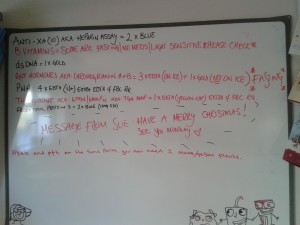Take a look at the picture of the whiteboard. Which of the messages is the odd one out?
 If you’re anything like me, it’s obvious. One, I understand; the others (although they are all in English, kind-of) I don’t.
If you’re anything like me, it’s obvious. One, I understand; the others (although they are all in English, kind-of) I don’t.
I came across the whiteboard before Christmas at the hospital where they were taking a blood test to check I was OK for the next round of chemotherapy. Apart from the season’s greeting, all the messages are reminders to nurses taking blood tests of some of the less obvious procedures to be followed when doing some of the rarer tests. It caught my eye because of the sheer strangeness of finding the two radically different uses of languages next to each other, as if they had something to do with each other. Wittgenstein said language was a toolbox with lots of different kinds of tools for different purposes: the whiteboard is then like finding the Space Shuttle launcher next to a teabag squeezer: both tools, but they have little else in common. It leaves me wanting to rejoice – isn’t language wonderful, that we can do all these different things with it! That there are all these different kinds of language, some understood by everyone, others, only by tiny communities with their own abbreviations and conventions, all allowing us to communicate as and when we want to. And as a scientist, it drives my research agenda: how can we talk scientifically about how all these different kinds of uses relate to each other? How can they be compared? Now that we linguists are getting the hang of corpora, we can start to be quantitative about the question as never before.
And there are funny little drawings at the bottom – another multi-faceted language x p
There are also messages here not in words. Equally impenetrable (to me). The apparent lack of skill in draughtsmanship is interesting. Are we more or less tolerant of inept drawing than of inept use of language (by which here I means words)? Many people (persons) might say “I cannot draw for toffee” but we all think we can write. Drawing starts with looking – maybe we are not very good at looking?
Hi Adam, you might enjoy looking at the literature on what distinguishes natural languages from other sequential information (like DNA sequences or computer code). It has been claimed that entropy does (by Rao et al.); Dick Sproat vigorously protests.
A student of mine and I applied Rao’s measures to artifical languages (Klingon, Lojban) and we found that Klingon patterns like NLs, Lojban less so.
https://homes.cs.washington.edu/~rao/IndusResponse.html
(Will send you our article if you are interested as well.)
I love your analogy: “the whiteboard is then like finding the Space Shuttle launcher next to a teabag squeezer:” The specialised language used to describe pharmaceuticals is one thing, but when you view a more general topic to do with human behaviour through the lens of socio-linguistic jargon you can feel put out, as at a social rebuff. Today, following our discussion, I looked up Politeness Theory (Brown, Levinson, et al) and the subtly technical use of such familiar words as “face” and “bald” at first had me scratching my head, (though not too hard). But it’s worth persevering: there are lots of nice distinctions there to mull over, such as the Three Stages of Favour-Seeking…